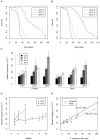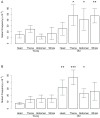Age- and temperature-dependent somatic mutation accumulation in Drosophila melanogaster
- PMID: 20485564
- PMCID: PMC2869313
- DOI: 10.1371/journal.pgen.1000950
Age- and temperature-dependent somatic mutation accumulation in Drosophila melanogaster
Abstract
Using a transgenic mouse model harboring a mutation reporter gene that can be efficiently recovered from genomic DNA, we previously demonstrated that mutations accumulate in aging mice in a tissue-specific manner. Applying a recently developed, similar reporter-based assay in Drosophila melanogaster, we now show that the mutation frequency at the lacZ locus in somatic tissue of flies is about three times as high as in mouse tissues, with a much higher fraction of large genome rearrangements. Similar to mice, somatic mutations in the fly also accumulate as a function of age, but they do so much more quickly at higher temperature, a condition which in invertebrates is associated with decreased life span. Most mutations were found to accumulate in the thorax and less in abdomen, suggesting the highly oxidative flight muscles as a possible source of genotoxic stress. These results show that somatic mutation loads in short-lived flies are much more severe than in the much longer-lived mice, with the mutation rate in flies proportional to biological rather than chronological aging.
Conflict of interest statement
The authors have declared that no competing interests exist.
Figures




References
-
- Failla G. The aging process and carcinogenesis. Annals of the New York Academy of Science. 1958;71:1124–1135. - PubMed
-
- Russell LB, Selby PB, von Halle E, Sheridan W, Valcovic L. Use of the mouse spot test in chemical mutagenesis: interpretation of past data and recommendations for future work. Mutat Res. 1981;86:355–379. - PubMed
-
- Kaya B, Marcos R, Yanikoglu A, Creus A. Evaluation of the genotoxicity of four herbicides in the wing spot test of Drosophila melanogaster using two different strains. Mutat Res. 2004;557:53–62. - PubMed
Publication types
MeSH terms
Grants and funding
LinkOut - more resources
Full Text Sources
Medical
Molecular Biology Databases

